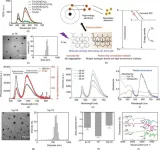(Press-News.org) Military-connected youth that show elevated risk for suicidal ideation and suicide plans exhibit lower rates of gun-carrying, according to new research from emergency medicine faculty at the University of Colorado School of Medicine.
The analysis, published in JAMA Network Open July 31 by members of the CU Center for Combat Medicine and Battlefield (COMBAT) Researchand Firearm Injury Prevention Initiative (FIPI), offers promising insight for potentially reducing gun-carrying among youths with recent suicidal ideation or plans. Researchers are also interested in how relevant strategies in military communities that reduce gun-carrying — which is associated with firearm-related harms, including suicide— could be applied to other populations.
“We began this research looking at how children of military service members are different than their peers who are not connected to the military,” says study co-author Ian Eisenhauer, MD, a Center for COMBAT Research fellow and lieutenant commander in the U.S. Navy.
“We know that military-connected families tend to have a lot of association with weapons and they’re around firearms quite a bit, so we expected to look at the data and find that these children with military connections are more likely to carry firearms than their peers who have similar risk factors, but we actually found the opposite to be true,” he continues.
Diving into national data
The researchers analyzed data from the 2021 National Survey on Drug Use and Health, a representative survey of noninstitutionalized U.S. civilians, looking at responses from youth 12 to 17 years old. Of the 10,045 youths included in the study, 4% reported past-year handgun carrying.
Military-connected youth with past-year suicidal ideations or suicide plans were found to have 26% and 76% decreased odds of reporting past-year handgun carrying, respectively.
“This study used nationally representative data from youth across the country,” explains Ian Stanley, PhD, assistant research professor of emergency medicine and psychological health lead for the CU Center for COMBAT Research, who co-authored the study. “We specifically looked at handgun carrying and military-connectedness among high-risk youth, or those who are reporting suicidal thoughts and plans.”
Risk and harm reduction efforts aimed at service members are common and service-wide, but researchers point out that these programs are not standard for all military dependents.
“Nonetheless, service-wide efforts to create community, reduce stigma, and promote lethal means safety specifically aimed at suicide prevention may have secondary effects on dependent youth. This includes registration requirements for weapons stored on a military base that specifically addresses child safety, including lock mandates and secure storage options,” the researchers conclude in their analysis.
A foundation for future research
Future research to study this phenomenon is already in the works, Stanley and Eisenhauer say. They’re designing further surveys tailored to military families that could reveal potential drivers of the positive association and what measures are working to reduce gun-carrying among youth who are at high risk of suicidal ideation and making suicide plans.
“The U.S. has a rich history of learning from the health care successes of its military. Many of the medical innovations and advancements that we benefit from today started in the military with servicemembers and their families,” says Stanley, who also works as the military and veteran lead for FIPI to study firearm injury risk reduction measures. “The same can be true for this finding—we can learn more about how to translate the findings and motivations around secure storage to the civilian sector.”
Eisenhauer emphasizes the positive news this study has for military families and how it may continue to push more progress forward.
“I hope that we can continue to support our kids to understand firearms and be safe around them,” he says. “I’m hopeful that this research can make a difference so that communities, military and civilian, are not wracked by suicide and devastating loss.”
END
Military health research reveals potential pathway to reducing youth suicide
New data analysis from the CU Center for Combat Medicine and Battlefield (COMBAT) Research finds military-connected youth who have reported suicidal ideation and suicide plans are less likely to report carrying firearms than their civilian peers.
2024-07-31
ELSE PRESS RELEASES FROM THIS DATE:
Cannabinoid CBG reduces anxiety and stress in first human clinical trial
2024-07-31
PULLMAN, Wash. — A lesser-known cannabinoid that is gaining in popularity Cannabigerol (CBG) effectively reduced anxiety in a clinical trial without the intoxication typically associated with whole plant cannabis. It may even have some memory enhancing effects, according to a new study in Scientific Reports.
For the study, Carrie Cuttler, an associate professor of psychology at Washington State University, and colleagues conducted the first human clinical trial investigating the acute effects of CBG on anxiety, stress and mood.
The research revealed that 20 mg of hemp-derived CBG significantly reduced feelings of anxiety at 20, ...
University hospitals nationally recognized for high-quality stroke care
2024-07-31
CLEVELAND — University Hospitals (UH) has received numerous American Heart Association Get With The Guidelines® - Stroke quality achievement awards for ensuring stroke patients receive the most appropriate treatment according to nationally recognized, research-based guidelines, ultimately leading to more lives saved and reduced disability.
Stroke is the No. 5 cause of death and a leading cause of disability in the U.S. A stroke occurs when a blood vessel that carries oxygen and nutrients to the brain is either blocked by a clot or bursts. When that happens, part of the brain cannot get the blood and oxygen it needs, so ...
Humans are born to run
2024-07-31
The 2024 Summer Olympics are in full swing. One of the marquee events is of course the marathon, a grueling test of fitness and athleticism.
When it comes to endurance running, humans are among the very top mammals in their athletic prowess. While we may not be the best sprinters in the animal kingdom, we can run steadily for long distances, even in hot weather. Our locomotor muscles are dominated by slow-twitch, fatigue-resistant fibers and our unique ability to sweat allows our bodies to effectively dissipate heat.
Humans are so good at endurance running, it seems we were born to do it. But why?
A theory of endurance
In ...
Medicaid enrollees struggle to find psychiatric care
2024-07-31
Many people enrolled in Medicaid who require psychiatric care have difficulty accessing clinicians in a timely manner despite the higher need in this population, according to a study by researchers at Weill Cornell Medicine.
The results published July 31 in JAMA found that few psychiatrists and other mental health professionals who are listed as accepting new patients enrolled in Medicaid are actually reachable and have appointments available. In cases when appointments could be made, wait times sometimes extended up to six months. The research was conducted by first author Dr. Diksha Brahmbhatt (M.D. ’24), who is now a resident physician at Brigham and Women’s ...
Smithsonian scientists devise method to secure Earth’s biodiversity on the moon
2024-07-31
New research led by scientists at the Smithsonian proposes a plan to safeguard Earth’s imperiled biodiversity by cryogenically preserving biological material on the moon. The moon’s permanently shadowed craters are cold enough for cryogenic preservation without the need for electricity or liquid nitrogen, according to the researchers.
The paper, published today in BioScience and written in collaboration with researchers from the Smithsonian’s National Zoo and Conservation ...
Revolutionary x-ray-sensitizers could transform cancer treatment with low-dose radiation therapy
2024-07-31
Researchers at Xiamen University have made a significant advancement in cancer treatment by developing a novel class of X-ray-sensitizers (XSs) that could revolutionize radiotherapy. Published in Engineering, their groundbreaking study highlights how specific organic pharmaceutical drug intermediates, derived from thioxanthone (TX), can be activated by low-dose X-rays to efficiently generate singlet oxygen for targeted cancer therapy.
Traditional radiotherapy, a cornerstone in cancer treatment, often involves high doses of radiation (typically over 50 Gy), which can lead ...
ATMs and other digital self-serve devices fail to meet accessibility needs
2024-07-31
Most self-service interactive devices — kiosks, ATMs and other digital interfaces — don't measure up to the accessibility needs of Canadians who report to have a disability, a new study has found.
In partnership with the CSA Group (Canadian Standards Association), University of Waterloo researchers interviewed people with lived experiences of disability and received an overwhelming consensus that most self-serve devices have little to no accessibility features or they have trouble finding ...
520-million-year-old worm fossil solves mystery of how modern insects, spiders and crabs evolved
2024-07-31
A new study led by researchers at Durham University have uncovered an incredibly rare and detailed fossil, named Youti yuanshi, that gives a peek inside one of the earliest ancestors of modern insects, spiders, crabs and centipedes.
This fossil dates back over 520 million years to the Cambrian period, when the major animal groups we know today were first evolving.
This fossil belongs to a group called the euarthropods, which includes modern insects, spiders and crabs. What makes this fossil so special ...
A new use for propofol in treating epilepsy?
2024-07-31
The general anesthetic propofol may hold the keys to developing new treatment strategies for epilepsy and other neurological disorders, according to a study led by researchers at Weill Cornell Medicine and Sweden’s Linköping University.
In their study, published July 31 in Nature, the researchers determined the high-resolution structural details of how propofol inhibits the activity of HCN1, an ion channel protein found on many types of neurons. Drug developers consider inhibiting HCN1 a promising strategy for treating neurologic disorders including epilepsy and chronic pain. The researchers also found, to their surprise, that when HCN1 contains ...
Trust in physicians and hospitals during the COVID-19 pandemic in a 50-state survey of US adults
2024-07-31
About The Study: The results of this survey study of U.S. adults suggest that trust in physicians and hospitals decreased during the COVID-19 pandemic. As lower levels of trust were associated with lesser likelihood of pursuing vaccination, restoring trust may represent a public health imperative.
Corresponding Author: To contact the corresponding author, Roy H. Perlis, MD, MSc, email rperlis@mgh.harvard.edu.
To access the embargoed study: Visit our For The Media website at this link https://media.jamanetwork.com/
(doi:10.1001/jamanetworkopen.2024.24984)
Editor’s ...
LAST 30 PRESS RELEASES:
The impact of family dynamics on eating behaviour – how going home for Christmas can change how you eat
Tracing the quick synthesis of an industrially important catalyst
New software sheds light on cancer’s hidden genetic networks
UT Health San Antonio awarded $3 million in CPRIT grants to bolster cancer research and prevention efforts in South Texas
Third symposium spotlights global challenge of new contaminants in China’s fight against pollution
From straw to soil harmony: International team reveals how biochar supercharges carbon-smart farming
Myeloma: How AI is redrawing the map of cancer care
Manhattan E. Charurat, Ph.D., MHS invested as the Homer and Martha Gudelsky Distinguished Professor in Medicine at the University of Maryland School of Medicine
Insilico Medicine’s Pharma.AI Q4 Winter Launch Recap: Revolutionizing drug discovery with cutting-edge AI innovations, accelerating the path to pharmaceutical superintelligence
Nanoplastics have diet-dependent impacts on digestive system health
Brain neuron death occurs throughout life and increases with age, a natural human protein drug may halt neuron death in Alzheimer’s disease
SPIE and CLP announce the recipients of the 2025 Advanced Photonics Young Innovator Award
Lessons from the Caldor Fire’s Christmas Valley ‘Miracle’
Ant societies rose by trading individual protection for collective power
Research reveals how ancient viral DNA shapes early embryonic development
A molecular gatekeeper that controls protein synthesis
New ‘cloaking device’ concept to shield sensitive tech from magnetic fields
Researchers show impact of mountain building and climate change on alpine biodiversity
Study models the transition from Neanderthals to modern humans in Europe
University of Phoenix College of Doctoral Studies releases white paper on AI-driven skilling to reduce burnout and restore worker autonomy
AIs fail at the game of visual “telephone”
The levers for a sustainable food system
Potential changes in US homelessness by ending federal support for housing first programs
Vulnerability of large language models to prompt injection when providing medical advice
Researchers develop new system for high-energy-density, long-life, multi-electron transfer bromine-based flow batteries
Ending federal support for housing first programs could increase U.S. homelessness by 5% in one year, new JAMA study finds
New research uncovers molecular ‘safety switch’ shielding cancers from immune attack
Bacteria resisting viral infection can still sink carbon to ocean floor
Younger biological age may increase depression risk in older women during COVID-19
Bharat Innovates 2026 National Basecamp Showcases India’s Most Promising Deep-Tech Ventures
[Press-News.org] Military health research reveals potential pathway to reducing youth suicideNew data analysis from the CU Center for Combat Medicine and Battlefield (COMBAT) Research finds military-connected youth who have reported suicidal ideation and suicide plans are less likely to report carrying firearms than their civilian peers.


